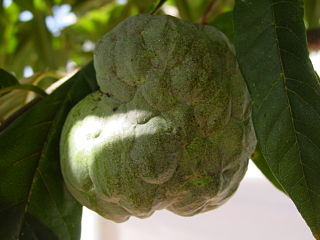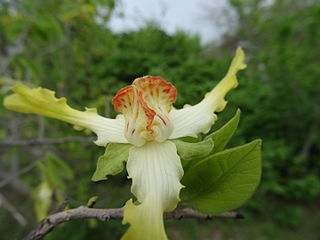
The Magnoliales are an order of flowering plants.

The Annonaceae are a family of flowering plants consisting of trees, shrubs, or rarely lianas commonly known as the custard apple family or soursop family. With 108 accepted genera and about 2400 known species, it is the largest family in the Magnoliales. Several genera produce edible fruit, most notably Annona, Anonidium, Asimina, Rollinia, and Uvaria. Its type genus is Annona. The family is concentrated in the tropics, with few species found in temperate regions. About 900 species are Neotropical, 450 are Afrotropical, and the remaining are Indomalayan.

Monodora myristica, the calabash nutmeg, is a tropical tree of the family Annonaceae or custard apple family of flowering plants. It is native to Angola, Benin, Cameroon, the Central African Republic, the Democratic Republic of the Congo, Equatorial Guinea, Gabon, Ghana, Guinea-Bissau, Ivory Coast, Kenya, Liberia, Nigeria, the Republic of the Congo, Sierra Leone, Sudan, Tanzania, Togo and Uganda. In former times, its seeds were widely sold as an inexpensive nutmeg substitute. This is now less common outside its region of production. Other names of calabash nutmeg include Jamaican nutmeg, African nutmeg, ehuru, ariwo, awerewa, ehiri, airama, African orchid nutmeg, muscadier de Calabash and lubushi.
Isolona is a genus of flowering plants in the family Annonaceae. There are 21 species native to Africa. They occur in humid habitat types.
Mkilua is a genus of plant in the family Annonaceae. It is native to Kenya and Tanzania. It contains a single species, Mkilua fragrans. Bernard Verdcourt, the British botanist who first formally described the species, named it after the fragrance of its flowers which smell like lemon. M. fragrans is monotypic. It is commonly called Mkilua Mwitu, Kilua and Kiluwa in Swahili, and Kingade in Digo. Volatile oils extracted from its leaves, flowers, and aerial parts have been reported to be repellent to Anopheles gambiae mosquitoes which are vectors for the malaria parasite Plasmodium falciparum. Bioactive molecules extracted from its roots have been reported to have antimicrobial activity in tests with Streptococcus agalactiae and Staphylococcus aureus.
Polyceratocarpus scheffleri is a species of plant in the Annonaceae family. It is endemic to Tanzania.

Polyceratocarpus is a genus of flowering plants in the family Annonaceae. All known species are native to continental Africa.
Toussaintia orientalis is a species of flowering plant in the family Annonaceae. It is native to Tanzania and Kenya. The single known population in Kenya may now be extinct, but the plant is relatively abundant at some sites in Tanzania.
Uvariodendron kirkii is a species of flowering plant in the family Annonaceae. It is found in Kenya and Tanzania.
Uvariopsis bisexualis is a species of plant in the Annonaceae family. It is endemic to Tanzania.
Uvariopsis is a genus of flowering plants in the family Annonaceae. The genus is unique to Africa, and consists of about 18 species, all of which are either ramiflorous, cauliflorous or both.
Annona stenophylla is a species of plant in the family Annonaceae. It is native to Tanzania and Zambia. Adolf Engler and Ludwig Diels, the German botanists who first formally described the species, named it after its narrow leaves.

Asteranthe asterias is a species of plant in the family Annonaceae. It is native to Kenya and Tanzania. Spencer Le Marchant Moore, the English botanist who first formally described the species using the basionym Uvaria asterias, did not explicitly explain the epithet, but was likely referencing the star-like appearance of its flower’s petals.
Monodora carolinae is a species of plant in the family Annonaceae. It is native to Mozambique and Tanzania. Thomas Couvreur, the botanist who first formally described the species, named it after his wife Carolina.
Monodora globiflora is a species of plant in the family Annonaceae. It is native to Tanzania. Thomas Couvreur, the botanist who first formally described the species, named it after its inner petals that touch one another, but are not fused, and form a globe-shaped structure.

Monodora grandidieri is a species of plant in the family Annonaceae. It is native to Kenya, Malawi, Mozambique, Somalia, and Tanzania. Henri Ernest Baillon, the French botanist who first formally described the species, named it after the French naturalist and explorer Alfred Grandidier who collected the specimen Baillon examined. It has been reported to be used as a traditional medicine by the Giriama and Digo people of Kenya.
Monodora hastipetala is a species of plant in the family Annonaceae. It is native to Tanzania. Thomas Couvreur, the botanist who first formally described the species, named it after its spear shaped petals.
Monodora junodii is a species of plant in the family Annonaceae. It is native to Eswatini, Kenya, Malawi, Mozambique, South Africa, Tanzania, and Zimbabwe. Heinrich Gustav Adolf Engler and Ludwig Diels, the German botanists who first formally described the species, named it after Henri-Alexandre Junod, the Swiss missionary and scientist who collected the specimen that they examined.
Monodora minor is a species of plant in the family Annonaceae. It is native to Mozambique and Tanzania. Heinrich Gustav Adolf Engler and Ludwig Diels, the German botanists who first formally described the species, named it after its small stature.
Asteranthe lutea is a species of plant in the genus Asteranthe. It is native to Tanzania. Kaj Borge Vollesen, the botanist who first formally described the species in 1980, named it after its yellow petals.





